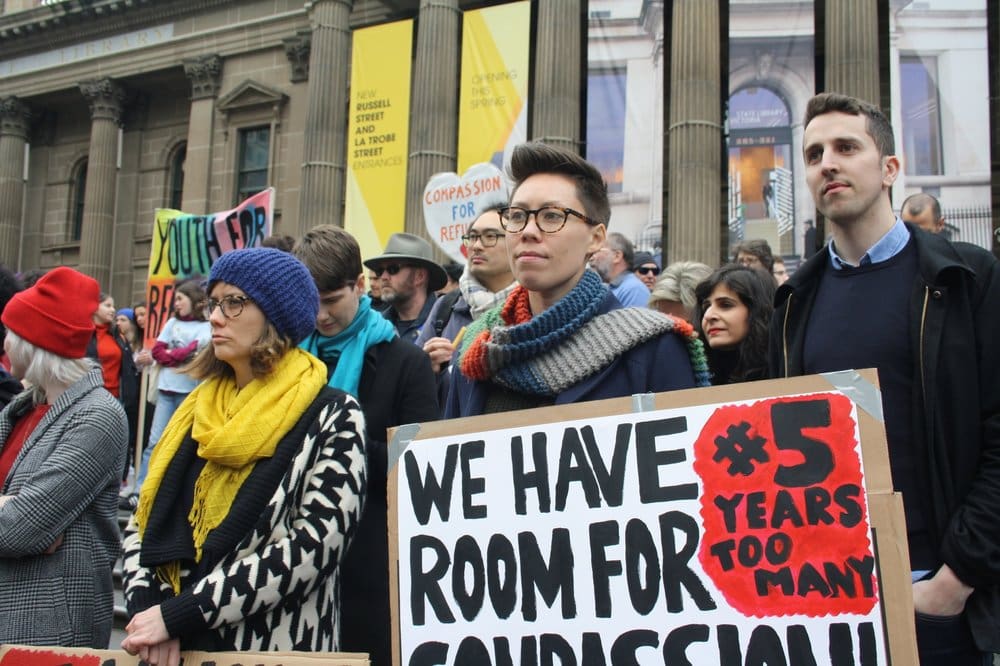Explainer: SA’s proposed anti-protest laws
The freedom to assemble and protest allows Australians to express their views on issues important to them and to press for legal and social change. Attending a protest is a way for people to have their voices heard and participate in public debate.
Australia has a proud history of protests leading to significant change, including the preservation of Tasmania’s Franklin River, the apology to the Stolen Generations, and the advancement of LGBTIQ rights by groups like Sydney’s ‘1978ers’, who started the annual Mardi Gras parade.
The Bill: Summary Offences (obstruction of Public Places) Amendment 2023 (SA)
On 18 May 2023, the South Australian Legislative Assembly introduced, and passed, the Summary Offences (Obstruction of Public Places) Amendment (The Bill) in response to protest activity in Adelaide which briefly closed traffic. The Bill amends section 58 of the Summary Offences Act 1953 (The Act) to, among other things, dramatically increase the maximum penalty for obstructing a public place. The Bill is currently before the Legislative Council for deliberation.
The definition of a “public place”
Section 4 of the Act defines a ‘public place’ as:
(a) a place to which free access is permitted to the public, with the express or tacit consent of the owner or occupier of that place; and
(b) a place to which the public are admitted on payment of money, the test of admittance being the payment of money only; and
(c) a road, street, footway, court, alley or thoroughfare which the public are allowed to use, notwithstanding that that road, street, footway, court, alley or thoroughfare is on private property;
Changes to the Act contained in the Bill
Section 2(1)
Section 2(1) of the Bill increases the penalty for obstructing a public place from $750 to a maximum of $50,000 or a maximum term of imprisonment of 3 months. This is a 60-fold increase to the maximum financial penalty; the Act does not currently provide imprisonment as a penalty for obstructing a public place. It is intended that these penalties would have a strong deterrent effect to protestors who block public space.
The maximum penalty indicates to the courts how Parliament views the seriousness of the offence and can determine the effective penalties people receive on the ground. While there are a range of fines that a court can impose, by including such a substantial increase to the maximum penalty, potential defendants would be facing the possibility of having much larger fines imposed on them because of these changes, as well as terms of imprisonment.
Section (3) (1a)
Section (3) (1a) of the Bill makes defendants criminally responsible for their direct obstruction of a public place, but it also intends to capture conduct even if it indirectly causes obstruction of a public place.
The Bill provides an example of what this may include, namely, if police or other emergency services need to restrict access to the public place to, “safely deal with the person’s conduct”. In other words, a person may be found guilty of an offence for the acts of police or other emergency services if they obstruct a public place while they respond to the defendant.
It is not clear from the text of the Bill what level of connection, proportionality or appropriateness is sufficient for police and emergency services to ‘safely deal’ with a person’s conduct under this new provision but there is a risk that under this provision, a person may be found guilty of an offence for the acts of police or other emergency services which are outside of their control.
Section (3)(1b)
Section (3)(1b) of the Bill would allow police and other emergency services to recover their ‘reasonable costs’ from defendants for dealing with the relevant obstruction. This is on top of any other penalty that a court may impose, like a fine or imprisonment.
When the Bill was introduced into Parliament, this amendment was described as one which would provide, “a strong financial disincentive”. Notably, the amendment concerning ‘reasonable costs’ also provides that, once a certificate of costs and expenses is provided by police or other emergency services for their responsive action, it is to be accepted as proof of those costs, unless there is evidence to the contrary.
It is anticipated that any defendant would be limited in their ability to provide contrary evidence as to costs and the process for challenging any certificate is not outlined in the Bill. It is therefore clear that the financial implications are likely to be severe for those found guilty of an obstruction offence under the Act.
Establishing the offence of obstructing a public place
Finally, the proposed amendments to section 58(1) in the Bill would make the offence of obstructing a public place easier to establish. Currently, under the Act, to establish the offence of blocking a public place, the conduct must be wilful. Under the Bill the blocking of a public place would have to be ‘intentional’ or ‘reckless’. Legally, there is a distinction between what is considered ‘wilful’ and what may be considered ‘intentional or reckless’.
The term ‘wilfully’ has been treated by Australian courts as being synonymous with concepts such as ‘intentionally’ and ‘deliberately’ (e.g. Lewis v Ogden (1983) 153 CLR 682; [1984] HCA 26). In this sense, an accidental or negligent act is not likely be enough to satisfy the requirement of ‘wilfulness’ as the case law suggests that the term also incorporates a sense of purpose. On the other hand, ‘intentional’ conduct usually refers to actual, subjective intention – a court would consider the natural and ordinary meaning of the word ‘intends’.
‘Recklessness’ is typically established where a person realised that the relevant harm may possibly be caused but they acted anyway (i.e. the person was cognisant of the relevant risks associated with their actions). The concept of ‘wilful’ usually incorporates both ‘intentional or reckless’.
Conclusion
The amendments contained in the Bill would significantly increase the penalties for obstructing a public place directly and indirectly, as well as make defendants potentially liable for costs incurred by emergency services responding to the obstruction.
Further, the amendments contained in the Bill would make the offence of obstructing a public place easier to establish and, in so doing, could capture a wide variety of conduct. For example, a person sleeping rough on a pavement, someone handing out flyers in a street, workers and their unions protesting for better pay, young people striking for climate action, or a situation where a person, due to illness or impairment, may not fully understand that they are blocking public space.
The changes contained in the Bill will ultimately undermine the ability of everyone in South Australia to exercise their right to peacefully protest.
This explainer is not legal advice
Note that this is a guide to provide general information only. It is not intended to be legal advice — you should do your own assessment of your situation under the laws, and seek legal advice if necessary. While this guide has been prepared with great care, we do not take responsibility for any errors in the information provided.
This summary was published on 23 May 2023.
You can read and download a PDF of this summary here
This summary was prepared by David Mejia-Canales, Senior Lawyer at the Human Rights Law Centre.
david.mejia-canales@hrlc.org.au

Explainer: Yoorrook Justice Commission finds systemic racism and calls for action
An explainer on the Yoorrook Justice Commission's final reports released on 1 July 2025.
Read more
Human rights briefing: Victoria’s anti-protest laws
The Victorian Government is proposing four major restrictions on the right to protest.
Read more
Explainer: NSW’s proposed laws on hate crimes and places of worship
If passed, new laws in NSW would have wide-ranging implications for the right to peaceful assembly and may lead to the criminalisation of conduct which does not impact on the rights of people to practice their religion and be protected from racial or religious hatred.
Read more



